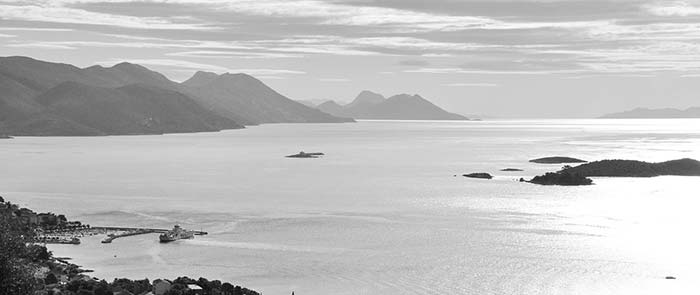
Hrvatska
Sunny beaches, succulent seafood, and a taste of la dolce vita...in Eastern Europe?
With thousands of miles of inviting seafront, Croatia’s coastline is Eastern Europe’s Riviera. Holiday-makers love its pebbly beaches, predictably balmy summer weather, and dramatic mountains. Croatia is also historic. From ruined Roman arenas and Byzantine mosaics to Venetian bell towers, Habsburg villas, and even communist concrete, past rulers have left their mark. And for thoughtful travelers, a trip to Croatia comes with an opportunity to better understand Europe’s most violent conflict since World War II: the breakup of Yugoslavia (see here). All in all, Croatia offers something to everyone—there’s good reason that it’s one of Europe’s hottest emerging destinations.
Where to Go: Croatia has more than 3,600 miles of coastline and more than a thousand islands. To be selective, zoom in on these three areas:
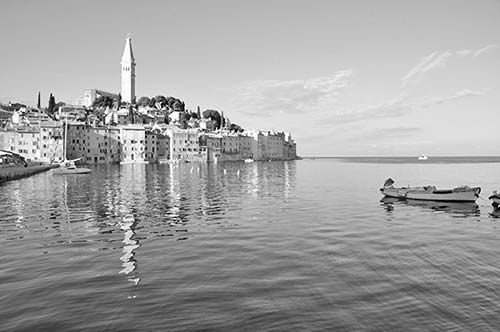
The Dalmatian Coast, a dramatic limestone coastline, features a bustling big city with the best ancient ruins in the country (Split); several alluring islands (most notably Korčula and Hvar); and Croatia’s showcase city: romantic, walled Dubrovnik.
Istria, a wedge-shaped peninsula in northern Croatia, has rolling hills, wineries, truffles, charming hill towns, ancient ruins (in Pula), and the finest coastal town between Venice and Dubrovnik: Rovinj.
The Croatian interior boasts the country’s surprisingly appealing capital, Zagreb, which lies near Hungary and Austria. And two hours south, deep in the countryside, is one of Europe’s top natural wonders, Plitvice Lakes National Park.
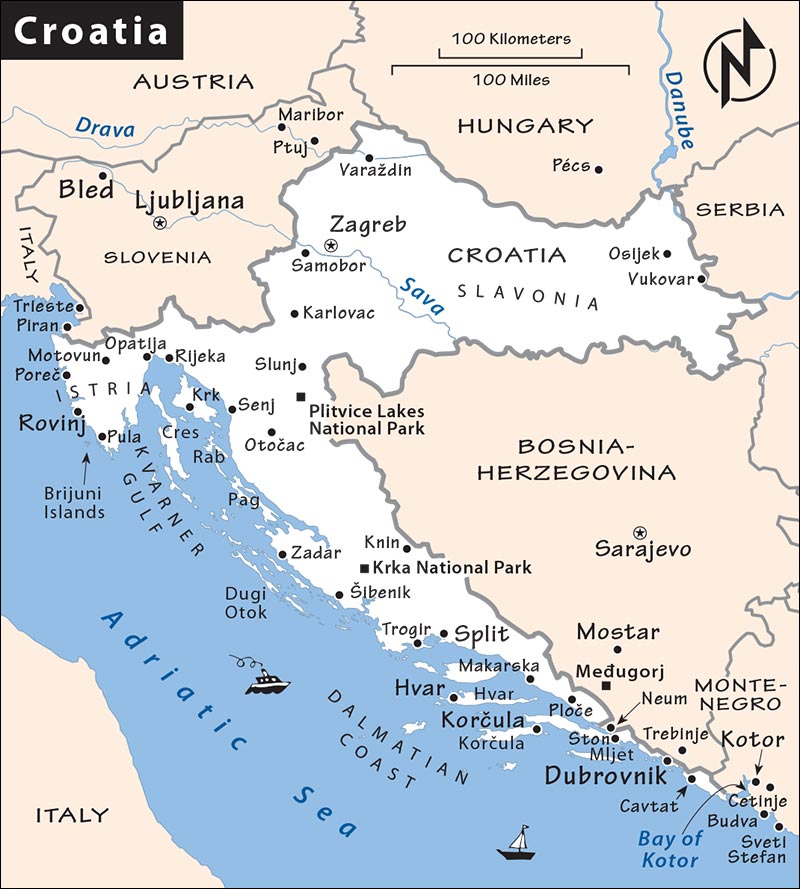
For a quick visit of just a few days, focus either on the Dalmatian Coast (and possibly add in some Bosnia and Montenegro—covered in the next two chapters) or on the sights in the north (Istria and the interior). With more time—a week or more—you can hit the highlights of all three regions.
Seasonality: Croatia is the most seasonal destination in this book. July and August are the peak of peak—everything is jammed up with European vacationers, and prices are high. Late May, June, September, and early October are the best times to visit...it’s cooler (but still warm) and less crowded. But off-season (after about mid-October, or before early May), while big cities like Dubrovnik and Split remain open for business, smaller towns close up tight.
Accommodations: Especially in the coastal towns, hotels tend to be big, overpriced resorts. Instead, carefully consider private accommodations: a sobe (room) or apartman (apartment). These offer double the cultural intimacy for a fraction the price of a big hotel—and many are quite comfortable and hotelesque, with modern amenities and all of the independence you like. For the best prices, book directly (I’ve listed websites for my favorites).
Getting Around: Croatia’s trains are of limited usefulness, but their bus network is strong (for schedules, see www.autobusni-kolodvor.com). Coastal destinations (including the islands) are well-connected by bus and by ferry—either big, lumbering car ferries (mostly operated by Jadrolinija, www.jadrolinija.hr) or speedy catamarans (handy ones on the Dalmatian Coast include www.jadrolinija.hr, www.krilo.hr, and www.gv-line.hr). Croatia is also easy for drivers, with excellent roads including a slick network of expressways (with tolls).
Croatian Cuisine: Like Italian fare, Croatian cooking includes lots of pasta, pizza, seafood, and pršut (prosciutto). Fill the tank at a pizzeria, but every so often splurge on a seafood feast. Try octopus salad or “black risotto” (a rice dish with cuttlefish simmered in its own ink). Ice-cream stands are abundant. In the interior, meat is popular (especially prepared with a peka—simmered under a metal baking lid covered in hot coals). While the cuisine scene in most of the famous coastal destinations is uninspired, Istria—with its proximity to Italy and abundant truffles—is a step above. Croatia also produces excellent wines (bijelo is white, crno is red).
Croatian Language: Most Croatians speak excellent English, so the language barrier is minimal. But just in case, here are a few helpful Croatian phrases: “Hello” is Dobar dan (formal) or Bok (informal); “please” is molim; “thank you” is hvala; and “Goodbye” is Do viđenija.
The following sections are designed to get you started planning a trip to Croatia. For in-depth coverage—including self-guided walks and museum tours, detailed hotel and restaurant listings, and lots of practical advice—consider my Rick Steves Croatia & Slovenia guidebook.
Of Croatia’s long coastline, the southern third—stretching 200 miles from Zadar to Dubrovnik—contains many of the country’s most popular destinations.
Dubrovnik is a living fairy tale that shouldn’t be missed. It feels like a small town today, but 500 years ago, Dubrovnik was an independent city-state and major maritime power, with the third-biggest navy in the Mediterranean. Still jutting confidently into the sea and ringed by thick medieval walls, Dubrovnik deserves its nickname: the Pearl of the Adriatic. Within the ramparts, the traffic-free Old Town is a fun jumble of steep alleys, low-impact museums, al fresco cafés, and kid-friendly squares. For tourist information, see www.tzdubrovnik.hr.
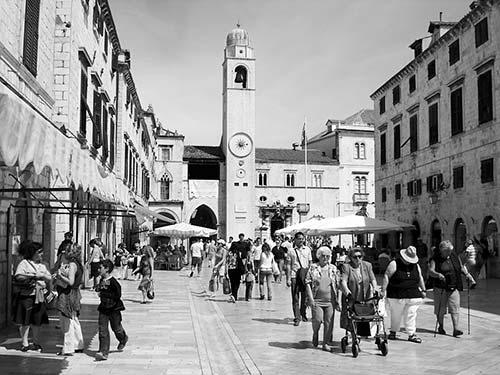
Visiting Dubrovnik: Though it’s a sprawling city of 50,000 people, most visitors focus on its compact Old Town. Simply strolling the ▲▲▲ Stradun (main drag) is a highlight. Several churches, museums, and other attractions hide within the City Walls. All of them are skippable, but it’s worth dipping into the fine ▲ Cathedral (with its quirky treasury collection); the restful cloisters of the ▲ Franciscan and Dominican monasteries (each with a modest museum); and the ▲ Rector’s Palace (the historical residence of the rulers of this independent city-state). The Old Town also has a historical synagogue, a finely decorated Eastern Orthodox Church and icon collection, good ethnographic and maritime museums, an aquarium, and a poignant exhibition of wartime photography.
Dubrovnik’s single-best attraction is strolling the scenic mile-and-a-quarter around the top of the remarkably well-preserved ▲▲▲ City Walls. As you meander along this lofty perch—with a sea of orange roofs on one side and the azure sea on the other—you’ll get your bearings, peer into secluded gardens, and snap pictures like mad of the ever-changing views. Walk the walls early or late—the ticket line gets long with cruise-ship passengers midday.
For an even higher viewpoint, ride the ▲▲▲ cable car from just above the City Walls up to the summit of Mount Srđ. There you’ll enjoy sweeping views down over the red rooftops of Dubrovnik, and out to offshore islands that recede into the sunset (www.dubrovnikcablecar.com).

The city can get very crowded midday, so it can be nice to escape to a nearby beach (several scenic spots line the road outside the Ploče Gate, southeast of the Old Town). Or head to the Old Port—at the mouth of the Old Town—where local captains offer sightseeing cruises. Popular destinations include little Lokrum Island (just offshore, great hiking and uncrowded beaches) and the Elaphite Islands (a trio of larger islands, each with small villages and beaches).
Sleeping in Dubrovnik: $$ Dubrovnik Gardens, an excellent value, is located in a private little garden inside the Old Town (Roberto and Marija, www.dubrovnikgardens.com). For private rooms on a sleepy, skinny, stepped lane inside the Old Town, try $$ Villa Ragusa (run by Pero, www.villaragusadubrovnik.com) or $$ Apartments Paviša (run by a different Pero, www.apartmentspavisa.com); if they’re full, their neighbors often have rooms. Other good rooms around town include the simple but cheery $ Plaza Apartments (Lidija, www.apartmaniplaza.com), the classy $$ Apartments Amoret (Branka, www.dubrovnik-amoret.com), and the upscale and trendy $$$$ Fresh Sheets Kathedral B&B (Jon and Sanja, www.freshsheetskathedral.com).
Eating in Dubrovnik: Avoid the overpriced tourist traps on the main drag and on the glitzy “restaurant row,” Prijeko street. One exception is Nishta, a well-run vegetarian eatery with an eclectic international menu (on Prijeko street, www.nishtarestaurant.com). For traditional Dalmatian food done well, try classy Dalmatino (Miha Pracata 6, www.dalmatino-dubrovnik.com) or Kopun, on a gravelly square facing a church (Poljana Ruđera Boškovića 7, www.restaurantkopun.com). To sample local wines (paired with light local dishes), don’t miss D’Vino Wine Bar (Palmotićeva 4a, www.dvino.net). And for the most scenic setting in town, get a drink at one of two bars called Cold Drinks “Buža”—that means “hole in the wall”—which is literally what you’ll have to climb through to reach these delightful perches, clinging like barnacles to the seaward side of the City Walls (ask locals for help to find the entrances).
Private Drivers: Many travelers splurge on hiring their own private driver for side-trips to destinations described in the next two chapters: Bosnia’s Mostar and Montenegro’s Bay of Kotor (figure around €250 for a full-day trip). Good options include Pepo Klaić (www.dubrovnikshoretrip.com) and Petar Vlašić (www.dubrovnikrivieratours.com).
Split (pronounced as it’s spelled) is Croatia’s second city, bustling with 178,000 people. If you’ve been hopping along the coast, landing in urban Split feels like a return to civilization. While most Dalmatian coastal towns seem made for tourists, Split is real and vibrant—a shipbuilding city with ugly sprawl surrounding an atmospheric Old Town, which teems with Croatians living life to the fullest. As this is a transportation hub for the coast, you’ll likely pass through at some point. It’s well worth spending a night (or more) to fully experience this underrated city. For tourist information, see www.visitsplit.com.

Though Split throbs to a modern, youthful beat, its history goes way back—all the way to the Roman Empire. And today, Split has some of the best Roman ruins this side of Italy. In the fourth century A.D., the Roman Emperor Diocletian (245-313) wanted to retire in his native Dalmatia, so he built a huge palace here. Eventually, the palace was abandoned. Then locals, fleeing seventh-century Slavic invaders, moved in and made themselves at home, and a medieval town sprouted from the rubble of the old palace. This—combined with Venetian influence starting in the 15th century—has left Split a fascinating study in the layers of history.
Visiting Split: The city’s top experience is exploring the ruins of ▲▲▲ Diocletian’s Palace, which are integrated into the townscape of the Old Town. The Old Town’s streets were literally the hallways of the palaces; you can see where later settlers grafted windows and doors onto the original structure. And those windows and doors are still in use today.
Begin by exploring Diocletian’s Cellars, the cavelike foundation that Roman engineers built to support the massive palace. Then head up to the Peristyle—once the palace’s grand entryway, it’s now the Old Town’s main square. Café cushions line the steps (buy a drink if you want to rest on one), and up the stairs is a majestic entry vestibule where a cappella singers perform traditional Dalmatian klapa music.
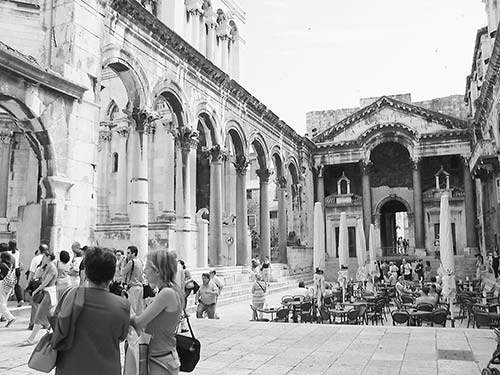
Towering over the Peristyle is the Cathedral of St. Domnius, which began life as Diocletian’s mausoleum. Inside, you can see what was supposed to be the final resting place of the emperor, who was notorious for torturing Christians. In a bit of poetic justice, today his mausoleum is a cathedral honoring those martyrs...and Diocletian is nowhere to be found.
Another wonderful experience is sauntering along Split’s main pedestrian promenade, called the Riva. Filling the area between the Old Town (Diocletian’s Palace) and the busy modern port, it’s the perfect place to people-watch, lick an ice-cream cone, or nurse a coffee. Best around sunset—when it seems the whole town is out strolling—this mellow scene also sprawls up Marmontova street from the harbor.
Most of Split’s museums (covering city history, archaeology, ethnography, and an old synagogue) are skippable. But one is a must: the ▲▲ Meštrović Gallery, displaying the works of local sculptor Ivan Meštrović (1883-1962). After a successful career in interwar Yugoslavia, Meštrović built a mansion and studio overlooking the Adriatic Sea on the outskirts of Split. Today that mansion—an easy bus or taxi ride from the Old Town—displays his expressive sculptures, which were greatly admired by his contemporary, Auguste Rodin. Meštrović’s works still grace parks and squares all over Croatia (and in Chicago, where the artist fled after World War II).
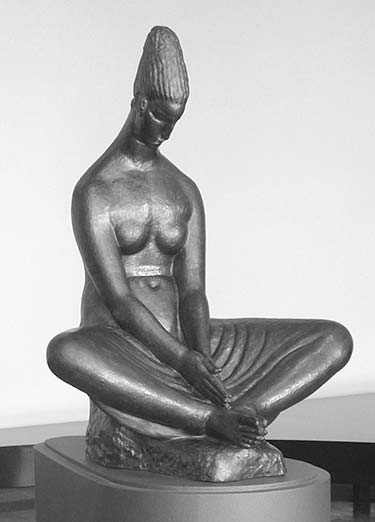
Split is also a great city for relaxing. It has several distinctive and inviting squares; a green park peninsula, called Marjan, with hiking trails and beaches; and a lively, user-friendly nightlife scene.
Sleeping in Split: Just outside of the Old Town are some small, well-run guesthouses, including $$ Villa Ana (www.villaana-split.hr) and $$ Villa Matejuška (www.villamatejuska.hr). Within the Old Town—which can be noisy at night, especially on weekends—you can splurge at $$$$ Marmont Hotel (www.marmonthotel.com) or the cozy luxury B&B called $$$$ Palača Judita (www.juditapalace.com), or sleep more affordably at $$ Kaleta Apartments (www.kaletaapartments.com) or $ Sobe “Base” (www.base-rooms.com).
Eating in Split: You’ll eat well inside the Old Town at the classic, fish-oriented Trattoria Bajamont (Bajamontijeva 3). Even better options are just a short walk west of the Old Town, in the Varoš neighborhood: cozy Konoba Matejuška (Tomića Stine 3), bustling Šperun Restaurant (Šperun 3), or the upscale Paradigma (Bana Jelačića ulica 3, www.jre.eu/paradigma).
Croatia is famous for its islands, and some of the most popular are in Dalmatia. Many travelers argue that their favorite island is the very best island, but I’ll let you in on a little secret: They’re all equally good. While each has its claim to fame, the Croatian islands are essentially variations on a theme: a warm stone Old Town with a Venetian bell tower, a tidy boat-speckled harbor, ample seafood restaurants, a few refurbished resort hotels on the edge of town, and sobe and apartman signs by every other doorbell. My two favorites are relatively well-connected to each other and to the mainland: ritzy Hvar and mellow, dramatically situated Korčula.
Hvar: Hvar’s hip cachet, upscale-ritzy “Croatian Riviera” buzz, and easy proximity to Split (one hour by express catamaran) have quickly turned this tidy Dalmatian fishing village into one of the most popular destinations in Croatia (www.tzhvar.hr). With a charming old town, a ruined fortress overhead, luxury yachts bobbing the harbor, and arguably the best nightlife in Croatia, Hvar is an enjoyable place to be on vacation. You can tour its churches, or visit the Benedictine convent where nuns make delicate lace from natural plant fibers. Or, to get out of town, enjoy one of the island’s beaches, go for a hike, or take a boat ride to the offshore Pakleni Islands.
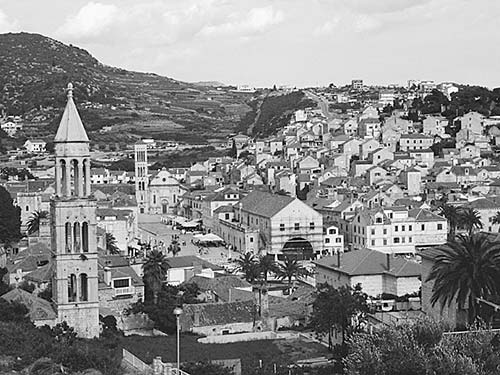
Good rooms in and near Hvar town include $ Ivana and Paško Ukić (in the steep lanes above the town center, www.hvar-apartments-center.com) and $ Apartments Mare (Marica and Gianni, a 10-minute walk west of the Old Town, www.apartments-mare-hvar.com). For a centrally-located splurge hotel, try $$$$ Villa Nora (http://villanora.incroatia.info) or $$$$ Hotel Park (www.hotelparkhvar.com).
For meals, consider Konoba Menego, serving Croatian classics tapas-style (in the steep lanes above the main square, www.menego.hr); Alviž, with simple but delicious meals near the bus station (Hanibala Lucića 1); or, for a splurge, Gariful Restaurant, with seafood along the harbor embankment (www.hvar-gariful.hr).
Korčula: The island town of Korčula (KOHR-choo-lah)—a bit closer to Dubrovnik, with workable connections—boasts an atmospheric Old Town, a smattering of little museums, and a dramatic, fjord-like mountain backdrop. Humbler and sleepier than its glitzy big sister Hvar, Korčula has an appealing backwater charm (www.visitkorcula.eu). The peninsular Old Town pokes out into the Adriatic, with fish-skeleton street plan, a variety of museums (including the supposed former home of Marco Polo, whom Korčulans claim was born here), and a variety of pizza, pasta, and seafood restaurants. Twice weekly in summer, Lazy Korčula snaps to life when locals perform a medieval folk dance called the Moreška.
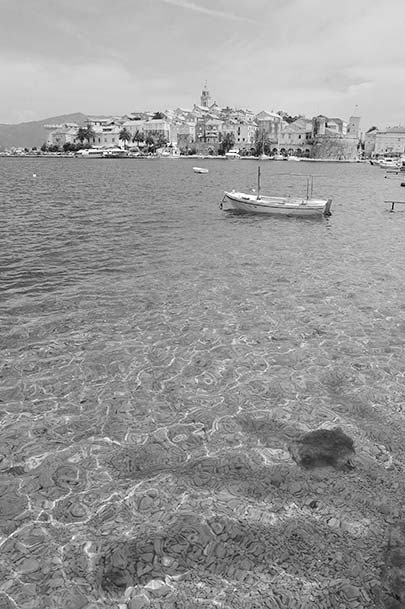
My favorite private rooms are $$ Apartments Lenni (Lenni and Pero, perisa.modrinic@du.t-com.hr), $ Old Town Apartments (Branko and Ulrike, www.juristic.de/korcula), and $ Royal Apartments (Zvonko and Marija, www.korcularoyalapartments.com). The best hotel option is $$$$ Hotel Korsal (www.hotel-korsal.com).
Several great restaurants—including Aterina and Nonno—are on the square called Trg Korčulanskih Klesara i Kipara. For a scenic setting, browse the eateries along the seawall, from the basic Pizzeria Tedeschi to the splurgy Filippi.
Idyllic Istria, the wedge-shaped peninsula at Croatia’s northwest corner, reveals itself to you gradually and seductively: Pungent truffles, Roman ruins, striking hill towns, quaint coastal villages, carefully cultivated food and wine, and breezy Italian culture all compete for your attention. The highlight is the gorgeous seaside town of Rovinj, but with more time (and a car), Istria has much to offer. Everything mentioned here is within a one-hour drive of Rovinj.
Among Croatian coastal towns, Rovinj (roh-VEEN) is particularly romantic (www.tzgrovinj.hr). Its streets are delightfully twisty, its ancient houses are characteristically crumbling, and its harbor—lively with real-life fishermen—is as salty as they come. Like a little Venice on a hill, Rovinj is the atmospheric setting of your Croatian seaside dreams.
Visiting Rovinj: Rovinj’s main attraction is simply its gorgeous ▲▲▲ Old Town—rising dramatically from the Adriatic as though being pulled up to heaven by its grand bell tower. Enjoy stunning views from the town parking lot, then walk into town, pausing at the lively open-air market. Once inside the Old Town, you’re swallowed up by a creaky and colorful townscape.
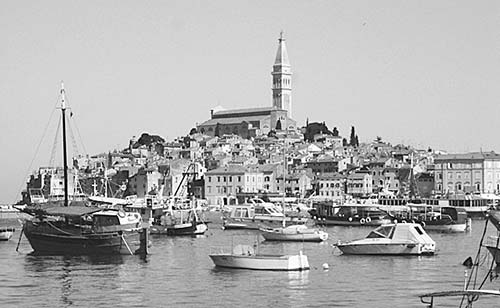
Narrow, stepped lanes climb up the hill to the ▲ Church of St. Euphemia, where you can learn about the local saint and climb rickety stairs up to the top of the bell tower. Rovinj has a few low-impact museums, including the ▲ House of the Batana Boat, celebrating a unique local fishing boat and the culture that goes along with it (www.batana.org). Rovinj has some rocky beaches, with sandy ones a short bike or boat ride away.
Sleeping in Rovinj: This town is a delightful home base for exploring Istria. The Old Town holds several appealing private rooms and guesthouses, including $$$ Villa Markiz (Andrej and Ivana, stylish apartments, www.markizrovinj.com), $$ Casa Garzotto (with rustic rooms and apartments scattered around the Old Town, www.casa-garzotto.com), and $$ Villa Cissa (tasteful apartments rented by engaging Veljko, www.villacissa.com).
Eating in Rovinj: Restaurants line up along Rovinj’s “restaurant row” facing the harbor; good options include classy Scuba, rustic Veli Jože, romantic Santa Croce, and—at the end of the strip—the scenic splurge La Puntuleina.
Rovinj also has delightful nightlife. Istrian wines are excellent, and Rovinj has two handy wine bars where you can learn more: Bacchus Wine Bar, just outside the Old Town gate at Carera 5 (Paolo), and Piassa Granda, on a charming little square right in the heart of the Old Town (Veli trg 1). For a memorable setting, keep an eye on the water as you stroll “restaurant row” to find Valentino Cocktail Bar, where you can nurse an overpriced drink “on the rocks”—literally—as the sun sets and fish come to investigate the underwater lights.
Istria’s interior is dotted with sleepy, picturesque hill towns, speckled with wineries and olive-oil farms, embedded with precious truffles, and grooved by meandering rural roads. Spend a half-day (or more) joyriding from town to town, stopping at some countryside wineries and making time for a truffle feast.
Visiting the Istrian Hill Towns: The most appealing hill town is Motovun, overlooking vineyards and truffle-filled oak forests. Hike up its shop-lined main street to the cute little square with a pretty church, a big hotel (the recommended Hotel Kaštel, www.hotel-kastel-motovun.hr), and views over the countryside. Motovun is also a foodie destination, with a pair of excellent restaurants for an Istrian meal: the trendy but unpretentious Mondo Konoba (just below the Old Town’s lower gate), and the more traditional Konoba pod Voltom (inside the Old Town’s upper gate).
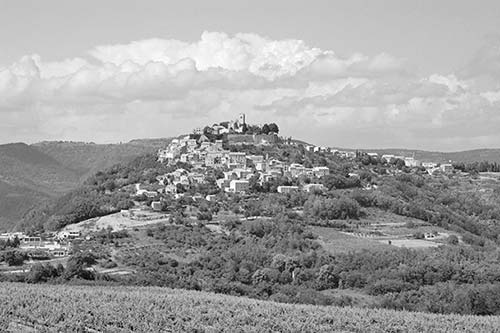
Other fine hill towns include Grožnjan (a time warp on a bluff—flatter and easier to drive to than Motovun), Buje (more workaday), and Završje (almost deserted and very atmospheric). Most towns have a restaurant specializing in truffle dishes, but Istria’s gastronomic epicenter is Livade, in the valley below Motovun. This is home to the local Zigante truffle company, with a big shop and upscale restaurant.
Wine lovers enjoy stopping for tastings at countryside wineries, which are scattered across the region. Near Momjan (northwest of Motovun), good choices are the traditional Kabola (www.kabola.hr) and the sophisticated Kozlović (www.kozlovic.hr).
At Istria’s southern tip, Pula is a big, industrial port city. But its urban core holds priceless ancient Roman ruins that rival Split’s. Park near the remarkably well-preserved amphitheater, which is worth touring. Then walk into the town center. On the main square (formerly the ancient forum) is a largely-intact ancient temple; a Roman floor mosaic hides behind some nearby shops.
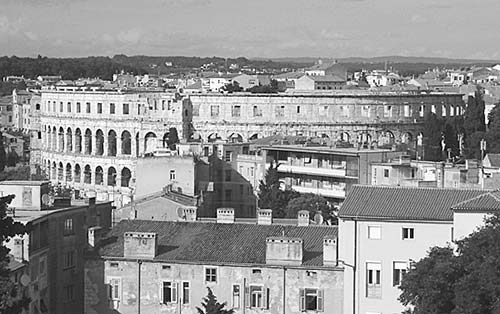
Most travelers to Croatia focus exclusively on the coast. That’s a shame, because they miss the country’s interior—with two of its best destinations: the capital city and a stunning natural wonder.
You can’t get a complete picture of modern Croatia without a visit here—away from the touristy resorts, in the lively and livable city that is home to one out of every six Croatians (pop. 790,000). In Zagreb, you’ll find historic neighborhoods, a thriving café culture, my favorite urban people-watching in Croatia, a nearly Prague-like Old World streetscape, and virtually no tourists. The city is also the country’s best destination for museum-going, and has Croatia’s best foodie scene—both of which are in short supply along the coast.
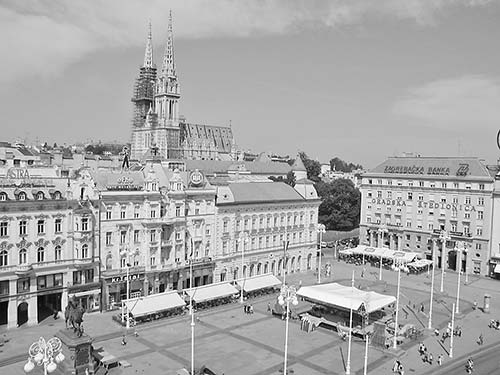
Visiting Zagreb: Zagreb’s main square, Jelačić Square (Trg bana Jelačića) is a hive of activity. Shoppers, commuters, and trams zip in and out of the square. The surrounding downtown zone is a delight to explore, with galleries, boutiques, and gourmet coffee shops.
Near Jelačić Square, a short funicular climbs up to Zagreb’s old town, called Gradec. Its centerpiece is St. Mark’s Square, where governmental buildings (including the parliament and president’s residence) face the colorfully tiled roof of the Church of St. Mark.
Two of Croatia’s top museums are within a block of St. Mark’s Square. The small but riveting ▲▲▲ Croatian Museum of Naive Art displays lovingly detailed works by self-taught peasant artists—dating from the early 20th century, when art-world insiders sought to prove that artistic ability was an inborn talent (www.hmnu.org). And nearby, the innovative ▲▲ Museum of Broken Relationships collects true stories of failed couples from around the world, tells their story in their own words, and displays the tale alongside an actual item that embodies the relationship (https://brokenships.com). The Gradec area also has a fine city history museum and an atelier and collection of works of the great Croatian sculptor, Ivan Meštrović.
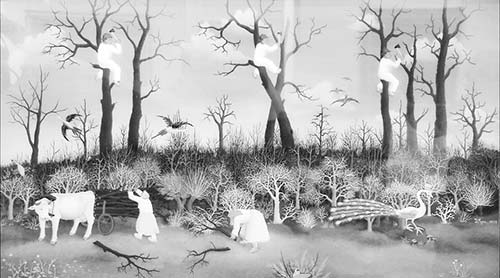
The adjacent, formerly walled district of Kaptol is home to Zagreb’s ▲▲ Cathedral—containing various monuments celebrating the city’s tumultuous history and Croatia’s proud Catholic heritage.
Between Gradec and Kaptol is Zagreb’s colorful (and largely untouristy) indoor-outdoor public market, a fun place to browse for a picnic. Nearby is the trendy café street called Tkalčićeva, with lots of lively al fresco eateries and the best people-watching in town.
Sleeping in Zagreb: Good, central choices include the cozy-yet-modern $$ Jägerhorn Hotel (www.hotel-jagerhorn.hr) or the big, well-located $$$ Hotel Dubrovnik (www.hotel-dubrovnik.hr). Smaller B&B-type options include $ Sobe Zagreb 17 (www.sobezagreb17.com) or $ 4 City Windows (www.4citywindows.com).
Eating in Zagreb: It’s fun to browse the restaurants along the bustling, traffic-free Tkalčićeva street, including the big, sloppy Pivnica Mali Medo (a Czech-style beer hall, at #36) or La Štruk, specializing in the local ravioli, štrukli (Skalinska 5). In Gradec, Trilogija feels upscale but still affordable and unpretentious (Kamenita 5, www.trilogija.com). And for foodie places in the downtown zone around Jelačić Square, check out Lari & Penati (Petrinjska 42A), Bistro Fotić (Ljudevita Gaja 25, www.bistrofotic.com), Mundoaka (international street food, Petrinjska 2), and Nishta (international vegetarian dishes, Masarykova 11).
Plitvice (PLEET-veet-seh) is one of Europe’s most spectacular natural wonders. Imagine Niagara Falls diced and sprinkled over a heavily forested Grand Canyon. There’s nothing like this lush valley of 16 terraced lakes, separated by natural travertine dams and laced together by waterfalls, boat rides, and miles of pleasant plank walks (www.np-plitvicka-jezera.hr).
Visiting Plitvice: Deep in the countryside about two hours south of Zagreb (roughly on the way to Split), Plitvice is worth a little extra effort to reach. It’s easiest for drivers, but many public buses from Zagreb or Split also stop here (bus stop along main road—ask locals or the driver to be clear on where to get off or on, best connections are provided by the summer-only Prijevoz Knežević express bus).
Once at the park, you can see the highlights in just a few hours’ walk. It’s easy (on well-tended paths and boardwalks), but can get crowded—in busy times, get an early start. (It works well to arrive in the evening, sleep near the park, hit the trails first thing the next morning, then move on to your next destination after lunch.) The lakes are divided into two sections, upper and lower. I prefer to buy my park ticket at Entrance 1 and do the Lower Lakes first. You’ll hike steeply down to the trail, then walk gradually uphill—past glorious cascades and pools of strangely colorful water—to the largest lake. From there, an electric boat shuttles you silently across to the Upper Lakes, which is yet another wonderland of boardwalks, waterfalls, and tranquil ponds. From the far end, you can ride a shuttle bus back to your starting point.

Sleeping and Eating at Plitvice: Most visitors stay at the national park lodges, which are functional but comfortable, and come with industrial-strength dining rooms. The best choices are $$ Hotel Plitvice and the slightly pricier $$ Hotel Jezero (book either through www.np-plitvicka-jezera.hr). For a more personal experience, drivers should stay at a family-run inn outside the park. My favorite, just a couple of minutes south of Plitvice, is the friendly $$ Plitvice Mirić Inn (www.plitvice-croatia.com). Others cluster near the road about 10 minutes’ drive north of Plitvice, including the homey, picturesque $ Villa Plitvička Sedra (www.restoran-sedra.hr) and the big, roadside $$ Hotel Degenija (www.hotel-degenija.com). Each of these also has its own restaurant—ideal for dinner. For lunch near the trails, a few humble eateries—ranging from basic groceries selling sandwiches to sit-down places—cluster near the national park entrances and near the boat dock at the top of the Lower Lakes. But the food at these official national park eateries is nothing special; consider packing a picnic instead.